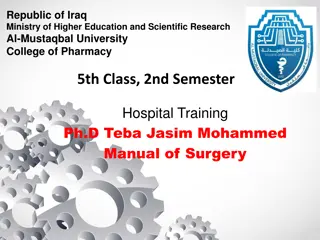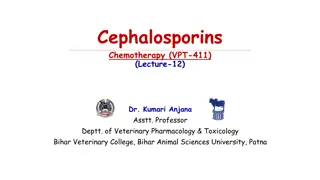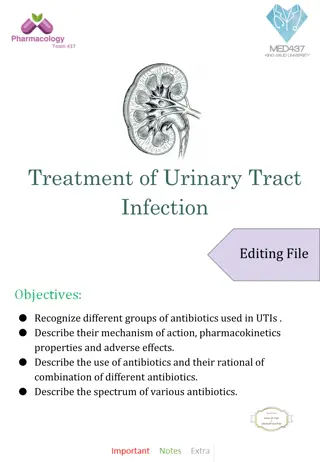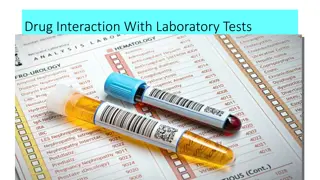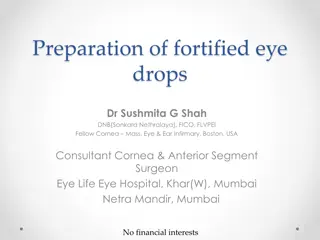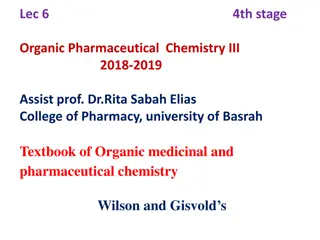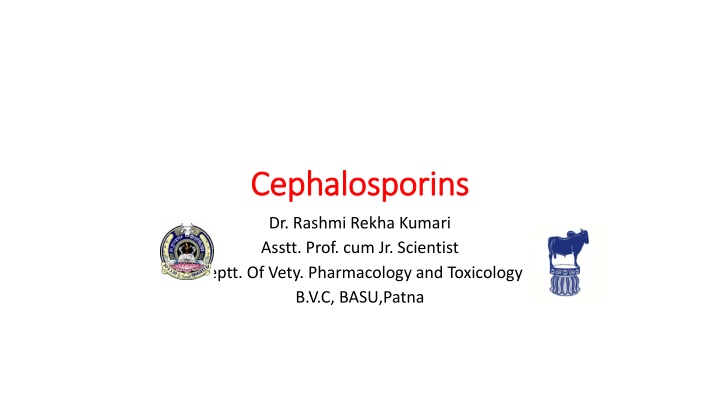
Cephalosporins
Cephalosporins, a group of antibiotics derived from Cephalosporium acremonium, play a crucial role in combating bacterial infections. This article delves into the history of cephalosporins, their chemical composition, and classification based on generations. Explore the spectrum of activity and the unique characteristics that set cephalosporins apart from other antibiotic groups.
Download Presentation

Please find below an Image/Link to download the presentation.
The content on the website is provided AS IS for your information and personal use only. It may not be sold, licensed, or shared on other websites without obtaining consent from the author. If you encounter any issues during the download, it is possible that the publisher has removed the file from their server.
You are allowed to download the files provided on this website for personal or commercial use, subject to the condition that they are used lawfully. All files are the property of their respective owners.
The content on the website is provided AS IS for your information and personal use only. It may not be sold, licensed, or shared on other websites without obtaining consent from the author.
E N D
Presentation Transcript
Cephalosporins Cephalosporins Dr. Rashmi Rekha Kumari Asstt. Prof. cum Jr. Scientist Deptt. Of Vety. Pharmacology and Toxicology B.V.C, BASU,Patna
In 1945, Cephalosporium acremonium was isolated from raw sewage from the sea in sardinia. The first cephalosporin, cephalosporin C was derived from this fungus. All other cephalosporins are semisynthetic antibiotics derived from cephalosporin C
The contain cephalosporanic acid consisting of A beta-lactam penicillins and A dihydrothiazine penicillins Cephalosporin a molecule amino 7- ring like unlike
Chemistry of Chemistry of Cephalosporins Cephalosporins Dihydrothiazine Rng Beta lactam Ring 7-Aminocephalosporanic Acid
Unlike the 6-aminopenicillillanic acid of penicillins, the 7- aminocephalosporanic acid molecule in cephalosporins provides more sites (R1 and R2) for chemical manipulation in the production of many semisynthetic cephalosporins. Addition of various group at the R position forms derivatives with differences in their antimicrobial activity, stability against beta lactamase, protein binding, intestinal absorption, metabolism and toxicity.
Classification: Based on when synthesised First Generation: Oral : Cephalexin, cephradine ,cefadroxil, cephalogylcin, Parenteral: Cefapirin, cefazolin, cephalothin, Cephalonia. Intramammary: Cefacetrile, cefapirin, cephalonium. Second Generation: Oral: Cefachlor, cefuroxime axetil Parenteral :Cefamandole, cefonicid, ceforonide, cefotoxifin, cefuroxime. Intramammary: Cefuroxime Third Generation : Oral : Cefixime, cefpodoxime proxetil, cefdinir, ceftibuten Parenteral: Cefmenoxine, ceftiofur, cefoperazone, cefotaxime, cefsulodin, ceftazidime, ceftizoxime, ceftriaxone Fourth Generation: Parenteral: cefepime and Cefpirome.
Spectrum of Activity Spectrum of Activity First Generation: Cephalosporins have high activity against Gram positive, effective againt all gram positive bacteria except enterococcus. Also effective against beta lactamase producing staphylococcus. They also have greater activity against members of enterobacteriaceae, than penicillin G. Relatively susceptible to cephalosporinase and are not effective against pseudomonas aeruginosa
Second Generation Second Generation These drugs have greater activity against many gram negative bacteria that are resistant to first generation drugs(e.g., resistant E. coli. Klebsiella, Proteus, Enterobactor) Relatively resistant to beta-lactamase from gram ve bacteria Cefoxitin and cefotetan belong to the cephamycin group and are often used clinically because of good activity against anaerobic bacteria(Bacteroides fragilis)
Third Generation Third Generation Have more activity against gram negative bacteria than earlier generation of cephalosporins All are highly resisant to betalactamase from gram negative bacteria. Only Ceftazidime and Cefoperazone have good activity against Pseudomonas aeruginosa Less active against gran+ve cocci. Ceftiofur has been used extensively in veterinary medicine especially in cattle and is also registered for use in horse and dog. A new addition to the Vety. Drug is cefovecin which is an injectable formulation that has an extremely long life compared to other cephalosporins.
Fourth Generation Fourth Generation Example: Cefepime and Cefpirome More potent than third generation cephalosporins Have spectrum of activity similar to third generation but more potent than it, active against gram +ve cocci, gram ve bacilli and Pseudomonas aeruginosa Active against beta lactamase producing strains of bacteria resistant to other beta lactam antibiotics Indicated for serious, hospital acquired infection including septicaemia, lower respiratory tract infection.

